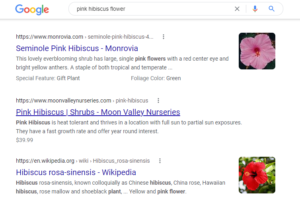In the world of search engine optimization, the only constant is change – big and small. To maintain visibility, it’s best to keep up with the most up-to-date practices to help prioritize your reach through even the most
Did you know that images on your website are a piece of the SEO puzzle? And now, an even bigger piece! The Google algorithms pick images with best practices in place and populate them in organic search result snippets.
A feature that was previously only available through paid search is now seen in organic results and can offer a new gateway for more visibility!
“The future of search will be about pictures rather than keywords.”
— Ben Silbermann
Pinterest CEO
An article by Brian Harnish discusses a Google Office Hours video in which Google’s Search Advocate, John Muller, shares that image snippets in organic search results are not necessarily based on indexed images, but rather on the context of the images, and proper documentation of those images. This means that the more information that is associated with images, the more likely it will be for those images to populate with your site in a search. Continue reading to learn about the power of images and how to optimize your images for search.
The Power of Photography
The presence of photography in web content is more important than ever. Research shows that images not only hold the power to increase information retention but also act as a hook, to draw the attention of the searcher. A search result that includes an image is often more likely to capture interest, be memorable, and drive your traffic.
According to a BusinessWire report, 59% of adults surveyed prefer visual information over textual information. An analysis completed by Jumpshot found that over 22% of all online searches are initiated through Google Images, the second most common method for searching by keyword after Google Web Search. According to John Muller of Google, the Google Search algorithms select the images that it believes would benefit users. As the owners of our websites, we have the ability to influence the perceived “quality” of our images for the algorithm to share.
Better incorporating images and keyword-rich image text into web content can lead to increased traffic to your site and overall better SEO.
Here’s How to Optimize Your Images For SEO:
Check your image size and type
The larger the file size, the slower it will load on your page. While .PNGs provide a higher quality image, they are much larger and impact the loading of a page, and therefore your usability. .JPEG files have a lower resolution but have a smaller file size. Formats like WebP can help you compress image file size without minimizing the quality.
Images should pair with content
Where your image is placed on your page is important. Add images to specific content pages, being mindful that the image pairs with the content within its vicinity.
Include descriptive titles, captions, filenames, and text for images
Search engines are text-based which means the information that the image contains is just as important as the image itself. Properly naming image files to correspond with the image description and the body text gives the Google algorithm clues as to the visual content of the image. For example, changing an image filename from a generic name such as IMG00045.png to a much more descriptive name such as pink-hibiscus-flower.png will give Google more context to associate with the body text.
Use descriptive Alt-text
Alt-text is used when a person cannot see the visual information on a page. It is the text that is displayed or read aloud when alternative screen viewing is being used or when a user has low bandwidth and cannot fully load a page. Additionally, Google reads the contents of alt text to gain additional information about the content of the image and therefore the page content as a whole. Alt-text should contain descriptive keywords that provide a distinct understanding of the image content. For example, the Alt-text for your image file pink-hibiscus-flower.png may be “pink hibiscus flower Florida garden .”
Design your site for multiple devices or platforms
Research by Think With Google showed that 85% of adults consume content on multiple devices at the same time. Designing your site to be equally accessible on multiple devices is essential.
Proper image optimization is a valuable SEO advantage now more than ever as Google Search is showing images for organic results. Updating your site content to reflect SEO best practices will provide you with optimal results and continue to increase the traffic flow to your site.
Whether you are a web writer, a developer, marketing manager, blogger, content creator, or business owner looking to optimize your own website performance, you don’t want to miss out on the power of images to boost your visibility and overall search engine results.
Our digital advertising management team at Web Marketing Therapy is diligently engaged with the nuances of Google Search, recognizing the subtle changes to SEO practices to provide you with the best tools and resources to support your growing business.
